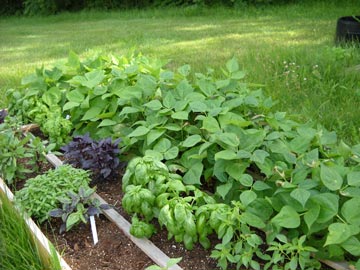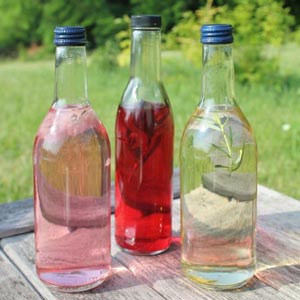Herbs are at their peak in summer and fresh herbs add taste to summer salads and dinners. Sadly, summer does not last forever, and gardeners think of recapturing the taste of summer by preserving the herbs. Many herbs can be dried or frozen but a few, like basil, are best preserved in another medium such as sugar, salt or vinegar. Tarragon flavored vinegar is a classic ingredient in French cuisine, particularly for use in fish or chicken recipes. Tarragon flavored vinegars are available in upscale supermarkets but French tarragon is not the only herb that lends itself to herb flavored vinegar. Rosemary/mint, basil, mixed herbs and chive blossom vinegars are wonderfully flavorful and easy to make at home. Unlike other methods of preserving food, herb vinegars do not take much work and do not steam up the kitchen!
To Start the Vinegar:
Take a quart sized glass jug or bottle (plastic can be used but the vinegar and herbs tend to taint the plastic making them useless for other storage purposes, so be sure you don't wish to use the plastic container again);
 Fresh basil varieties
Fresh basil varieties
© Kate Copsey
Gather:
One quart, good wine vinegar – usually white, but red wine vinegar is good for a Rosemary/mint mix; a large bunch of freshly picked herbs. Aim for about an ounce of herb material per quart. Some stems can be included;
- Rinse the herbs and drain well on paper towels;
- Add the herbs to the jug;
- Add the wine vinegar so that it covers the herb material;
- Stir and mash the herb material to break it up;
- Cover tightly with plastic film or a lid;
- Place in a dark place for 6-8 weeks – agitating the material a few times so that you get all the oils out;
- When the color and flavors are to your satisfaction, drain the vinegar mix – first drain through a colander to get the bulk material out of the mix. Drain a second time through a paper towel (line the colander with the towel) to get any small pieces out of the mix;
- Rebottle the vinegar in a vessel of your choice – again glass is preferred – and cap securely.
- If you wish, put a fresh sprig of herb into the vinegar before capping but make sure that it is covered by the vinegar.
 Red Basil, French Tarragon and Chive Blossom all make colorful vinegars.
Red Basil, French Tarragon and Chive Blossom all make colorful vinegars.
© Kate Copsey
Chive blossom vinegar and red basil both make colorful vinegars and they have great flavor too. Herb vinegars can be used directly on salads or in meals that need a punch of flavor. And remember, they always make beautiful gifts.
After harvesting your herbs, give them a dose of plant food so that they re-grow quickly for another late summer harvest.
By Kate Copsey: Garden writer and author